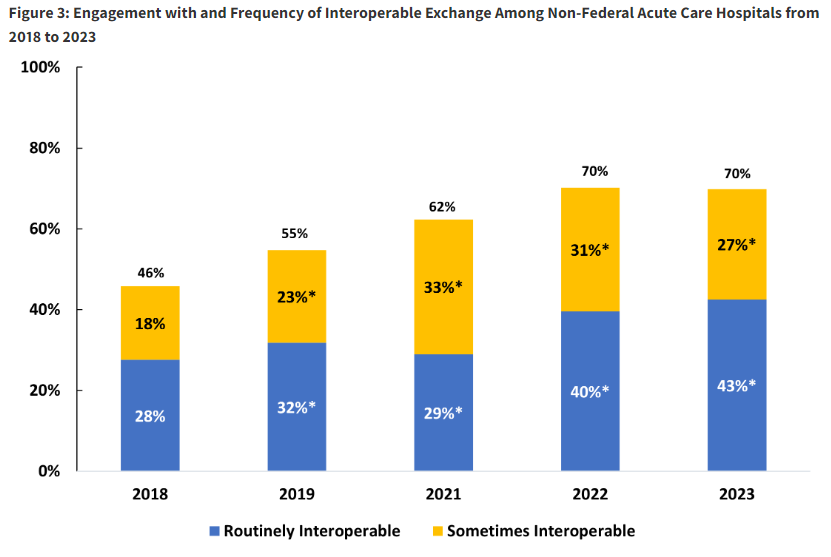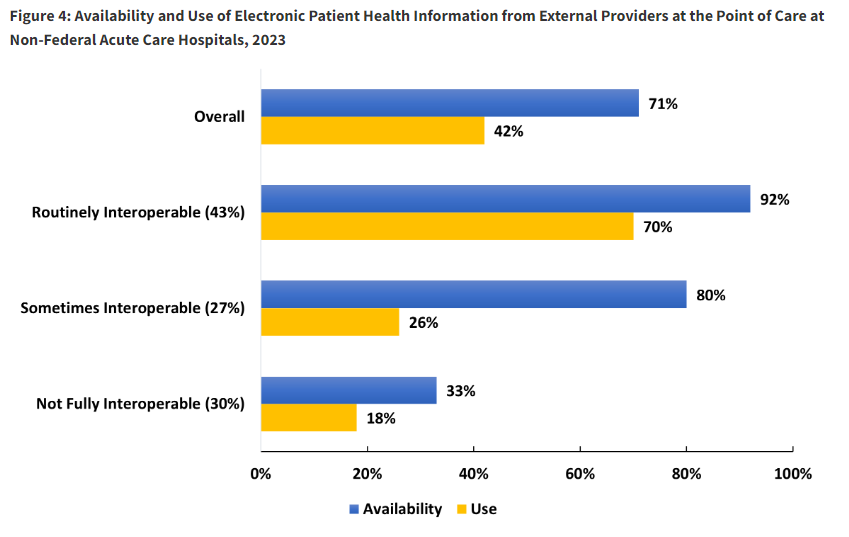
The Last Steps to Interoperability
In the news recently is a report stating that 70% of nonfederal acute care hospitals are at least ‘sometimes’ engaging in all four aspects of healthcare interoperability: sending, receiving, querying, and integrating external data. This figure represents a consistent increase as nearly a decade ago, only 23% were engaging in all four interoperability domains.
There’s still plenty of room to go in terms of driving regular engagement with this information as when the definition changes from ‘sometimes’ to ‘routinely’ engaging in all interoperability domains, the figure is at 43%.
While there is a bit of stagnation in the 2023 survey, it’s important to note that it was completed back-to-back with the previous year due to pandemic delays. On a more regular timeframe, the graph would have a steady incline versus a plateau.
While the increases are encouraging, they haven’t been uniform across the industry. For example, among large hospitals (>400 beds), 53% are routinely using interoperability while the number dips to 46% for medium (100-399 beds) and to 38% for small (<100 beds) hospitals. Other categorizations of hospitals indicated higher levels of interoperability included being urban vs. rural, system-affiliated vs. independent, and not being a Critical Access Hospital.
Further survey data revealed just how much of a difference it makes to have external patient data integrated as more of a habit. Despite high data availability for both the ‘sometimes’ and ‘routinely’ groups, there is a massive gap (43%) between the two in how often clinicians actually use the data.
Interoperability, simply the ability to share and use computerized data, has also drawn heated conversation recently. In a scathing blog post, Oracle’s Executive Vice President Ken Glueck rebutted the contents of a Business Insider article that criticized the rollout of the Oracle/Cerner EHR at the Department of Veterans Affairs. While touting Oracle’s APIs and agnostic features he also took the opportunity to criticize rival Epic, even going so far as to say that, “everyone in the industry understands that Epic’s CEO Judy Faulkner is the single biggest obstacle to EHR interoperability.”
In a blog post calling out hyperbole, it’s an interesting choice to call anyone the biggest anything, but it certainly grabs your attention. But given the progress that we’ve seen in under a decade, if Judy Faulkner and Epic are the biggest roadblock to interoperability, she’s slowing things down more like a speed bump than a brick wall.
As continued progress is made, the ONC will need to move its focus toward the more difficult use cases. Even routinely interoperable hospitals only send summary of care records to locations like long-term post-acute care facilities and behavioral health providers. These types of facilities are more of a challenge as they’re both smaller data partners for hospitals and also have more limited data exchange capabilities.
Things will also become more difficult as smaller organizations with fewer resources move toward interoperability. It’s likely that institutions serving large geographies, particularly specialty fields like pediatrics, oncology, and transplant, will be receiving ‘paper’ from local labs and the like for the foreseeable future. This paper might be in the form of an efax or a pdf, but it won’t be available as discrete data unless you have a team manually entering all of the data or a solution like Extract’s software.
Our technology can not only automatically classify and index your incoming documents, but it will match them to patients, orders, and encounters while abstracting key discrete data points for delivery to the EMR. Please send us a message if you’re interested in seeing how to interface your difficult paper documents.




